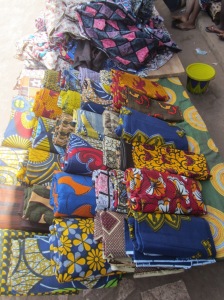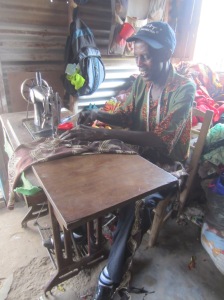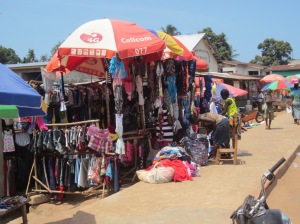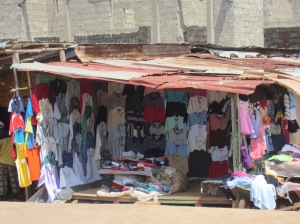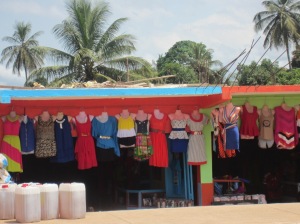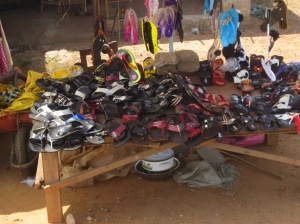Liberians look good. Personal appearance is very important – dare I say paramount? – at home, at school, on the job, and around town. Dirty or tattered clothing is considered disrespectful and even shameful. Instead, clothes are brilliantly-clean, crisply-pressed, and carefully-chosen. (Children are exempt from this rule.) Liberians get their clothing from one of three main sources: locally-made lappa clothing, new Chinese-made clothing, or second-hand. And wherever they get it, it looks good!
Lappa
One of the quintessential Liberian items, lappa is the colorful cloth found all across West Africa. Lappa (pronounced lah-pah) is a piece of fabric (3’ by 6’) that is attractive and multi-purposed. Lappa can be used as blankets, towels, wraps, sacks, sun shades, etc. However, the most common use for a lappa is as a woman’s apron. Nearly every Liberian woman “ties lappa” when doing chores and manual labor. If the woman has a baby, the baby is tied to its momma’s back in a makeshift lappa baby sling – an iconic African image.
Much of the formal clothing worn for church and business is made from lappa. Lappa fabric can be bought in most markets for $2-$20 USD, depending on the quality. The flashiest and most expensive lappa, often with gold accents, is widely known as “Obama Lappa,” because it is “fine like Obama.” (Needless to say, our president is popular in Liberia.) Tailors are plentiful and can turn out a full suit or dress in a few days. A tailor might charge $10 USD to sew a full suit. All said and done, you can have a custom-tailored suit for twenty bucks! Our own lappa wardrobes are ever-expanding!
Men usually wear a lappa shirt with dress trousers and dress shoes. Women wear “lappa suits,” which are two or three-piece outfits: long skirt, short-sleeved top, and optional matching head-wrap. Sometimes even mother and baby will coordinate, with a matching baby sling.
Lappa is a strong part of the Liberian culture. It didn’t take us long to develop a collection of lappa clothing for church and school. Whenever we don our lappa, we receive numerous comments such as “You’re an African man now!” or, “I really love your style today!” For us, wearing lappa is a great way to show our respect and integrate into the community.
Ticket Clothing
A large amount of the clothing worn throughout Liberia is secondhand from the West. Ticket clothing, as it is known, gets its name from the Goodwill tags that are still attached when the clothing arrives in-country. Ticket clothing comes to Liberia in large shipments from the US or Europe. The clothes arrive sorted by category and include everything from shirts to shoes to bags to underwear, even stuffed animals. The ticket items are then sold at informal auctions to people who will sell them all around the country.
The final sale prices of ticket clothing can vary, but aren’t too different from Goodwill prices in the US. T-shirts can be as little as $20 LD (about 25 cents). Blue jeans can go for $150 LD (about $2 USD). Ticket bags, such as purses and backpacks, are in high demand and can fetch more than $20 USD. Shoes can sell for thirty dollars or more. And if you think $30 is too much for a pair of funky Goodwill shoes, you should how pristinely clean they look after a Liberian has scrubbed and polished them. Most of the shoes honestly look new.
Because so much of the clothing in Liberia comes secondhand from America, you will frequently see items originating from your hometown. For example, being from Minnesota, we’ve noted Regions’ Hospital t-shirts, Mahtomedi baseball jerseys, and University of Saint Thomas messenger bags. It is fun and interesting to see where all the used clothing comes from. And while we can get excited to see something from our home state, we have learned to avoid the following conversation: “Hey, your shirt is from my town!” This conversation goes nowhere. The best you can hope for is a blank stare. The wearer probably chose the shirt for its color, size, price, or simple practicality, and not for the words across the chest.
In fact, on many occasions we have been perplexed by a person’s failure to consider the message on their t-shirt. For example, people can be seen wearing Confederate flags, inappropriate sexual references, or even Swastikas. I’m not sure if Liberian fashion has become ironic, but sometimes I wonder.
On an amusing note, we see a lot of people sporting Greenbay Packers gear, but we hardly ever see anything from the Minnesota Vikings. I’m not sure what this means, exactly, but it is fun to speculate. To Angie and me, it’s a bad sign for the Packers!
One of the refreshing aspects of Liberian fashion is that most clothing is gender-neutral. It’s not uncommon to see men wearing women’s skinny jeans and jellie sandals. A person’s wardrobe is selected for practical reasons. Liberians are generally short in stature, and women’s jeans fit better. Likewise, jellie sandals are waterproof and work great in the rainy season.
Chinese Clothing
The preferred clothing type of the younger generation is new clothing from China. This clothing arrives in Liberia in truck-sized containers, direct from Chinese factories. T-shirts, polos, blouses, dresses, blue jeans, and short trousers show up individually-wrapped in plastic. And since all the clothes arrive in the same shipping container, all vendors get the same thing. Within days, the entire city can be seen sporting the latest item.
“Chinese clothing,” as Liberians call it, is trendy and flashy, but usually of low quality. It is not made to endure. In fact, for durability, Liberians prefer American ticket clothing. Chinese clothing just can’t withstand many sessions on the washboard. Regardless of its low durability, Chinese clothing is expensive. Shirts are $10, while trousers or dresses can cost as much as $20 USD. When you account for the average Liberian income of one dollar per day, the cost of Chinese clothing is surprisingly high. Relatively speaking, new clothing in Liberia is far more expensive than clothing in America.
Looking Good
Liberians love to look good. Their wardrobes are always clean, pressed, and coordinated. A main weekend activity, especially for youth, is to show off their newest outfit, or as they would say,“bluff their latest dress code.” Likewise, adults show up at work and church looking their finest. And despite the pervasiveness of the secondhand market, we rarely see anyone wearing dirty, faded, or torn clothing. Instead, we are constantly impressed by Liberians’ style, flair, and pride in their personal appearance.

